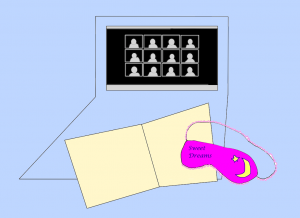How Students Working Virtually Can Reduce the Toll of Eye Strain
March 30, 2021
Every student and employee working from home can relate to having bright lights that glare at their eyes from computer screens when attending class or working online. When the day comes to an end, many people’s new normal consists of excessive headaches, optic pain, back and neck pain, and extreme fatigue. One of the main culprits for these symptoms is the excessive eye strain that many people are experiencing from staring at screens all day. Instead of reaching for painkillers, people can use these tips to help limit the impact on their eyes while working from home.
The Human Eye
The human eye is a fluid-filled sphere that has three layers of tissue that receive light and visual images which are then carried to the brain. The retina is the innermost layer that receives light focused on the lens, converting the light into neural signals and sending these signals to the brain for visual recognition.
The main function of the eye is to get light to the retina and start phototransduction, the process in which a particular wavelength activates photoreceptors that send electrical signals to the brain. The circular structure of the eye maximizes the surface area that light and energy can pass through. The vitreous humor, a thick gelatinous structure that occupies space between the back surface of the lens to the retina, maintains the eye shape and cleans out debris in the eye.
Computer Vision Syndrome
According to the American Optometric Association, computer vision syndrome is described as an ocular vision problem caused by persistent computer, tablet and cellphone use. Due to the pandemic, the majority of schoolchildren nationwide have switched to mandatory e-learning that replaces an 8- to 12-hour school day to attend class in front of a screen.
Sitting in front of these devices exposes individuals to harmful high-energy waves that are emitted through the screen. These waves penetrate the eyes and cause photochemical damage to the retinal cells, increasing susceptibility to dry eye from age-related macular degeneration.
Retinal cells get input from neurons that are located in the inner surface of the retina of the eye. These neurons receive visual information from photoreceptors and send the signals to the brain for visual recognition.

Additionally, macular degeneration can cause loss of vision and blurriness because of the wear and tear of the macula. This occurs because the macula gives us the ability to have perfect vision and reception of color, which can be negatively affected by eye strain and the emission of high waves into the eye.
Joan E. Roberts, a professor of chemistry in the natural sciences department at Fordham Lincoln Center, emphasized that the main reason for digital eye strain is the harmful wavelengths of 440-400 nm being emitted, which can be removed by wearing blue light-blocking glasses. She recommended that students “remove these wavelengths of light after 5 PM to avoid disruption of nighttime circadian rhyme and sleep.”
The effect of the world’s shift toward a massive online platform can affect many aspects of our health that may cause problems later on, including a greater risk of nearsightedness.
Tips To Alleviate Eye Strain
There are three main ways to reduce stress and strain to the eye. First, since there is immense light from the screen of a device, one should opt for natural lighting in the room where one is most often on a device. The use of dim, soft light or simply just opening the blinds can help diminish the harmful effects of too much light from the screen.
Second, the position of your body, device and desk is key. The University of Utah Health states that setting “screens about an arm’s length away and a bit below your line of vision protects eyes, as well as the neck and posture.”
Finally, Roberts shared another tip that will help when one focuses on the computer too hard — an activity that results in the reduction of blinking. She advised people to “look away from your computer screen every 15 minutes and stand up every hour, just to stretch your muscles for at least a minute.”
Overall, the pandemic has caused much stress in all aspects of life, from school to mental health. Taking time for yourself and going outdoors for a short walk or stroll is shown to reduce the progression of nearsightedness and make one feel happier.
















